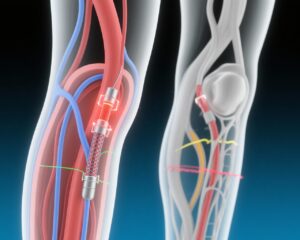亮点
- 紫杉醇涂层器械在1年内未能改善接受下肢动脉内膜重建术的间歇性跛行患者的生活质量。
- 中位随访时间为7.1年的长期死亡率无显著差异;然而,紫杉醇涂层器械组的5年死亡率高于非涂层器械组。
- 鉴于缺乏生活质量改善和潜在的死亡风险,该研究结果质疑了在这一患者群体中常规使用紫杉醇涂层器械的做法。
- SWEDEPAD 2试验采用了一项务实、多中心、基于注册的随机对照设计,对超过1100名患者进行了稳健的随访数据收集。
研究背景与疾病负担
外周动脉疾病(PAD)是一种常见且进展性的疾病,其特征是供应下肢的动脉发生动脉粥样硬化闭塞,导致缺血症状如间歇性跛行。跛行限制了患者的活动能力和生活质量,因为运动时会出现腿部疼痛。使用球囊和支架进行下肢动脉内膜重建是恢复股浅段血流的常用方法。
药物涂层器械,尤其是紫杉醇涂层器械,已开发用于通过抑制新生内膜增生来降低再狭窄率。尽管被广泛采用,但这些器械是否能带来有意义的患者中心结局改善(如疾病特异性生活质量或减少死亡率)的证据仍不一致且不明确。一些先前的荟萃分析提出了对紫杉醇涂层器械晚期死亡率增加的担忧,进一步增加了对严格前瞻性试验的需求。
研究设计
瑞典外周动脉疾病药物洗脱试验2(SWEDEPAD 2)是一项务实、参与者盲法、基于注册的随机对照试验,在9年时间(2014年11月至2023年9月)内于22个瑞典血管中心进行。入选标准为年龄18岁或以上,根据Rutherford分类1-3定义的间歇性跛行患者,计划进行下肢动脉内膜干预。主要排除标准包括急性血栓栓塞性或动脉瘤性下肢动脉疾病。
成功通过导丝后,参与者以1:1的比例随机分配至接受紫杉醇涂层球囊或支架或等效的非涂层器械,按中心分层,通过安全的网络注册系统隐藏分配。主要疗效终点是在1年内由患者感知的生活质量,使用血管生活质量问卷-6(VascuQoL-6)进行测量,这是一种经过验证的PAD特异性工具,评估症状、活动和社会方面。
次要终点包括中位随访时间为7.1年的全因死亡率。该试验旨在平衡务实的应用性和严格的随机化方法,利用瑞典全面的血管注册数据和高随访完整性(98.3%)。
关键发现
共有1155名患者被随机分配:577名接受紫杉醇涂层器械,578名接受非涂层器械;1136名(98.3%)有随访数据可供分析。中位年龄为73岁,性别分布均衡,33.7%的患者患有糖尿病。大多数患者表现为严重跛行(Rutherford 3),接受了股浅段干预(96.1%)。
在1年内,两组之间未观察到疾病特异性生活质量的显著差异——VascuQoL-6评分仅相差-0.02(95% CI -0.66至0.62;p=0.96),表明紫杉醇涂层器械在缓解症状或功能状态方面没有益处。
关于安全性,整个随访期间的全因死亡率统计上相似(HR 1.18;95% CI 0.94-1.48;p=0.16)。然而,在5年窗口期的分析显示,紫杉醇组的死亡率显著较高(每100人年4.57 vs 3.28),危险比为1.47(95% CI 1.09-1.98;p=0.010),这与之前的荟萃分析安全担忧一致。
其他重要发现包括相似的操作成功率和并发症率,尽管研究的主要重点强调了以患者为中心的生活质量和长期死亡率终点。
专家评论
SWEDEPAD 2试验解决了早期荟萃分析提出的使用紫杉醇涂层器械后晚期死亡风险的关键临床争议。值得注意的是,这项试验强调,尽管理论上具有抗增殖优势,但这些器械并未转化为接受下肢动脉重建术的间歇性跛行患者的生活质量改善。
观察到的5年死亡率增加需要谨慎解读。生物合理性仍有争议,因为紫杉醇的局部药物递送可能对身体虚弱的老年患者,特别是有心血管合并症的患者,构成系统性风险。虽然绝对风险增加较小,但患者、临床医生和指南委员会应考虑这些发现,以便在共同决策和器械选择中加以考虑。
SWEDEPAD 2的局限性包括治疗医生未设盲(仅参与者设盲),尽管进行了随机化,但仍可能存在残留混杂因素,以及未能完全剖析死亡原因,这可能阐明机制性风险途径。然而,试验的务实设计和全面的注册随访增强了其外部有效性。
当前的外周动脉疾病指南可能需要修订,以反映这些复杂的安全性和有效性数据,特别是在倡导个性化方法而不是在间歇性跛行患者中常规使用紫杉醇涂层器械方面。
结论
SWEDEPAD 2试验提供了强有力的证据,表明在Rutherford 1-3期外周动脉疾病患者中,紫杉醇涂层器械在1年内与非涂层器械相比没有生活质量改善。此外,与紫杉醇涂层器械相关的5年死亡率显著增加引发了重要的安全问题,不支持在这一人群中常规使用这些器械。
这些发现突显了仔细选择患者、透明的风险收益讨论以及继续研究更安全有效的下肢动脉重建技术的必要性。未来的研究应重点关注紫杉醇系统效应的机制理解以及替代药物涂层或器械技术。
参考文献
- Nordanstig J, James S, Andersson M, et al; SWEDEPAD试验研究者. 紫杉醇涂层与非涂层器械在间歇性跛行患者下肢动脉内膜重建中的应用(SWEDEPAD 2):一项多中心、参与者设盲、基于注册的随机对照试验。Lancet. 2025年9月13日;406(10508):1115-1127. doi:10.1016/S0140-6736(25)01584-3. PMID: 40902614。
- Brodmann M, Krishnan P, Bausback Y, et al. 药物涂层球囊与标准经皮腔内血管成形术治疗股浅动脉和腘动脉外周动脉疾病的长期结果:ILLUMENATE关键试验。Circ Cardiovasc Interv. 2018;11(2):e005891。
- Katsanos K, Spiliopoulos S, Kitrou P, et al. 在下肢股浅动脉中应用紫杉醇涂层球囊和支架后的死亡风险:随机对照试验的系统评价和荟萃分析。J Am Heart Assoc. 2018年12月18日;7(24):e011245。



